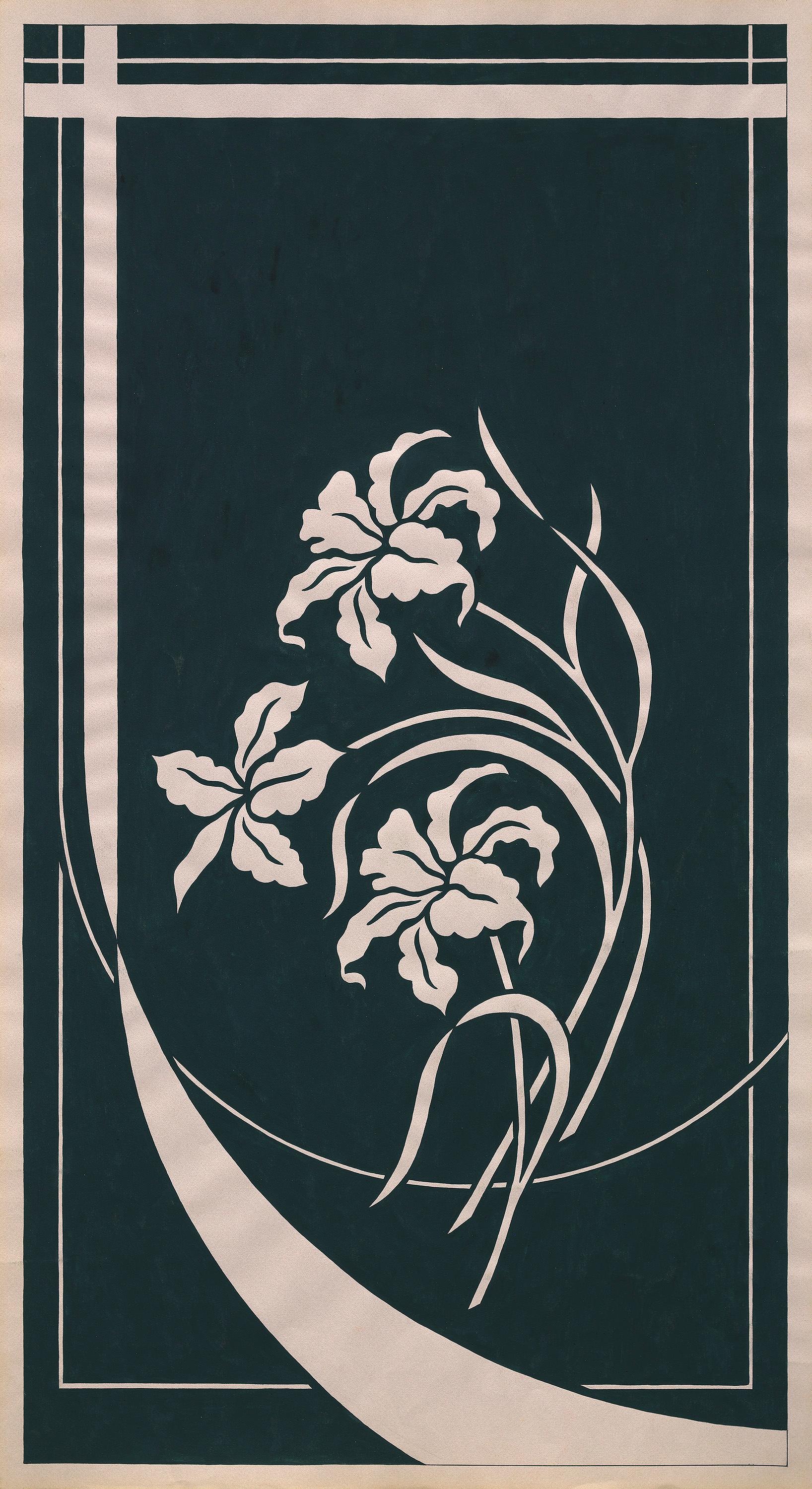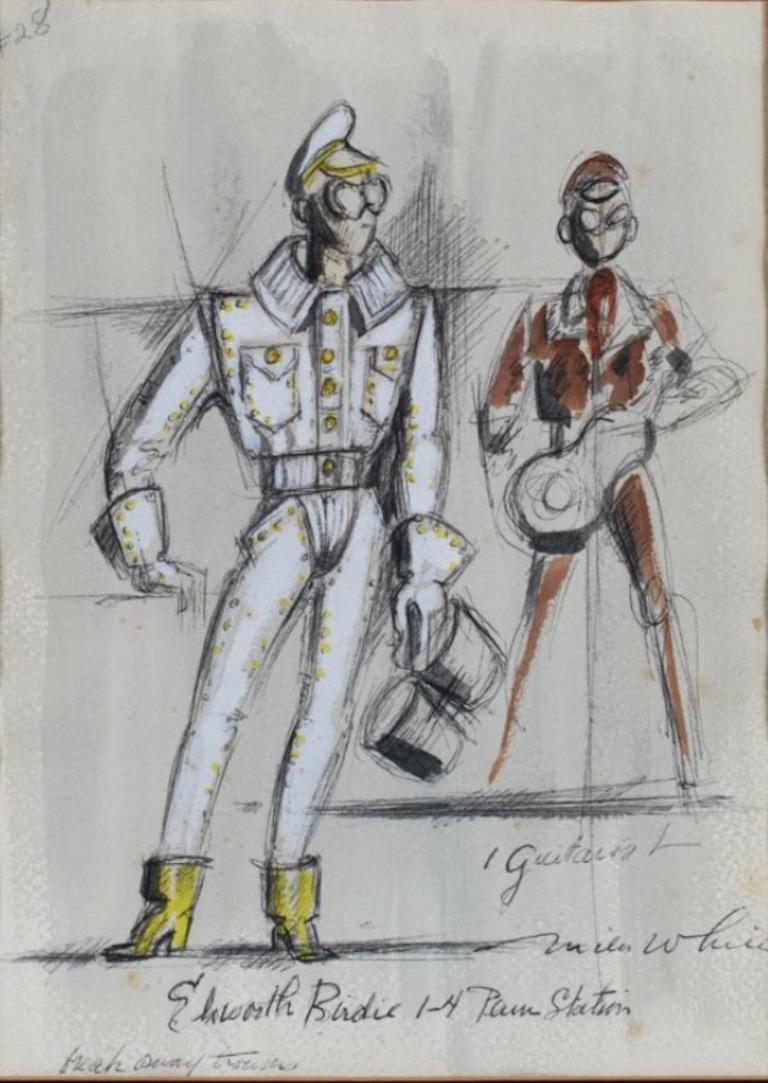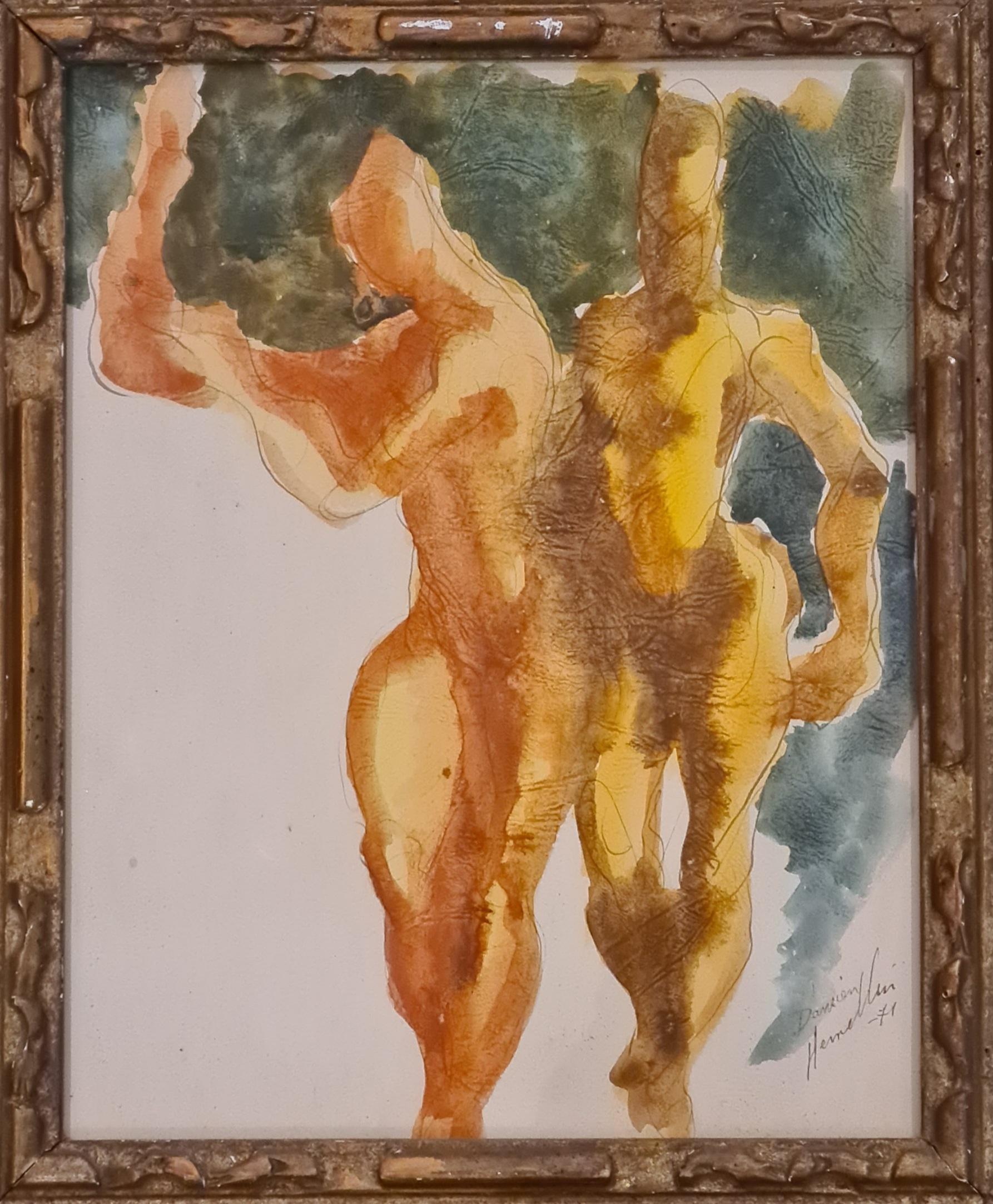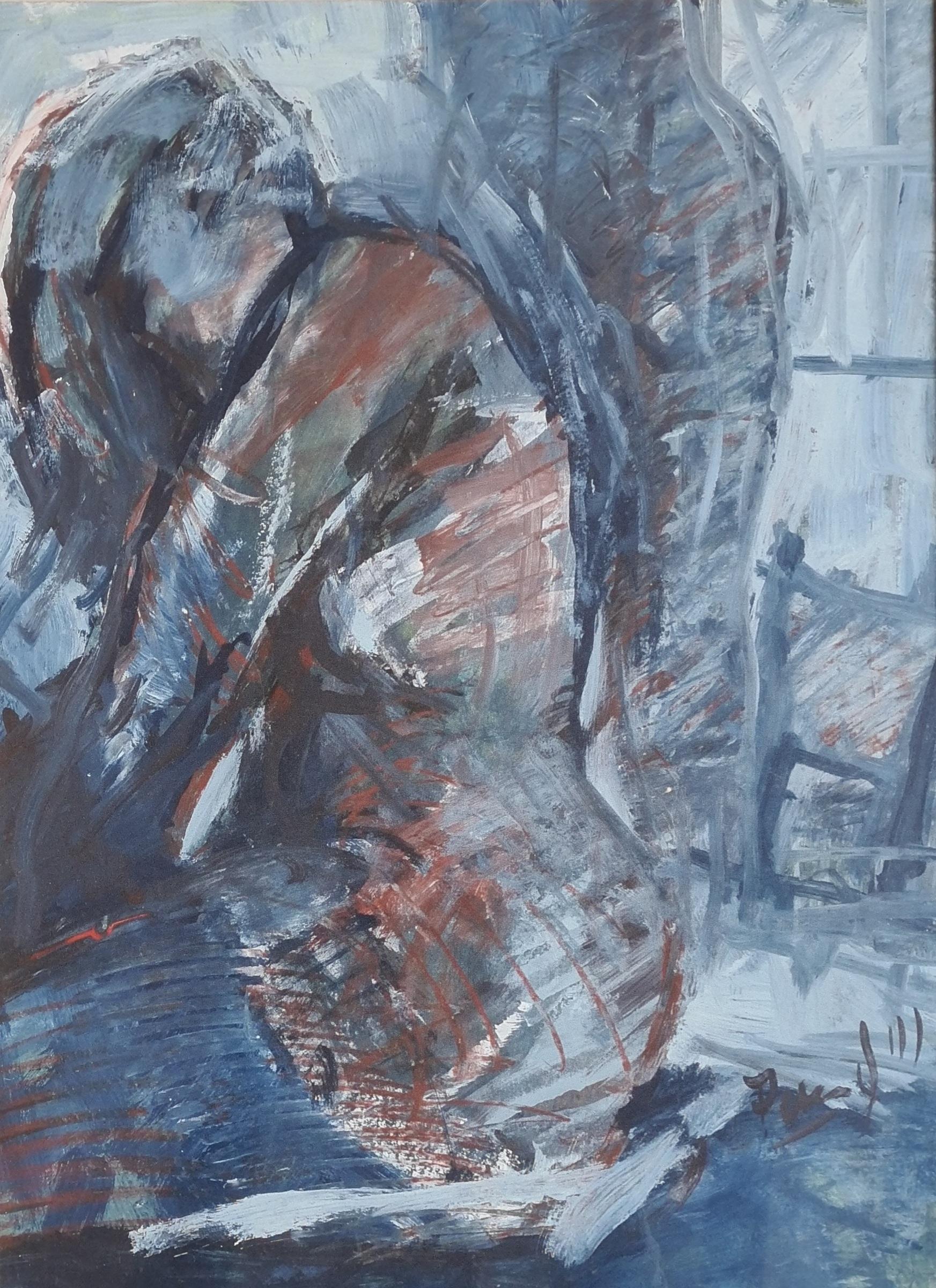Items Similar to Old Yishuv, Israel, Watercolor Gouache Painting Israeli Modernist Kibbutz Artist
Want more images or videos?
Request additional images or videos from the seller
1 of 9
Aharon GiladiOld Yishuv, Israel, Watercolor Gouache Painting Israeli Modernist Kibbutz Artist
About the Item
Signed in English and in Hebrew Abstract Expressionist bold, vibrant, colorful watercolor painting.
Aharon Giladi, Israeli painter, born in Russian Empire, 1907-1993
Aharon Golodetz (later Giladi) was born in Belarus, Russia to a wealthy family. In 1923-1926, he studied at the Leningrad Academy of Art. In 1926, he was exiled to Siberia for Zionist activity. In 1929, he immigrated to the Land of Israel, then Palestine, and helped to found Kibbutz Afikim in the Jordan valley. In 1934, he married Dvora Sifelman and worked as a builder and plasterer. He began to draw sketches of kibbutz life and taught art locally. His dynamic lines link subject to subject and figure to figure, displaying the magical nexus between objects and figures while reserving the characteristic elements of each. Everything accords with the invisible spirit which hovers over all. In 1942, he published a book of sketches with a foreword by the Hebrew author and poet Lea Goldberg. In 1948, Giladi left the kibbutz and moved to Kfar Saba. He won the Dizengoff Prize twice, exhibited in the Biennale of Venice in 1946, and was awarded the Dizengoff Prize again in 1954. In 1952, he published an album of drawings of the laying of the oil pipeline between Eilat and Beersheva with a foreword by David Ben-Gurion. He had a solo show in Paris in 1955 and in 1956. In 1955, Giladi settled in Holon and maintained a studio in Safed.
Giladi's early work was influenced by the Paris school in his use of color and expressive brushwork. He gradually moved toward abstraction, painting figures without faces and employing a dark palette. In his later years, he used oil pastels.
Education
1923-1926 Leningrad Academy of Art
Awards And Prizes
1954 Dizengoff Prize for Painting and Sculpture
1958 Dizengoff Prize
1957 Prize, Sao Paolo Biennale, Brazil
1960 The Histadrut Prize
General Exhibition
Art Gallery of the ''Habima'' Building, Tel Aviv, 1941
Artists: Shemi, Menahem Frenkel, Itzhak Castel, Moshe Atar (Aptekar), Chaim Litvinovsky, Pinchas Stematsky, Avigdor Streichman, Yehezkel Levanon, Mordechai Kossonogi, Joseph Naton, Abraham Shorr, Zvi Hendler, David Lubin, Arieh (Leo) Paldi, Israel Gliksberg, Haim Zaritsky, Yossef Baser, Robert Ziffer, Moshe Sternschuss, Moses Priver, Aaron Giladi, Aharon Krize, Yehiel Feigin, Dov
Taarohat Hasmona Taarohat Hasmona, Art Gallery of the ''Habima'' Building, Tel Aviv, 1942
Artists: Streichman, Yehezkel Naton, Abraham Giladi, Aharon Krize, Yehiel Meirovich, Zvi Stematsky, Avigdor Aroch, Arie
Katz Art Gallery, Tel-Aviv 1942
Artists:Avni, Aharon Berger, Genia Giladi, Aharon Zaritsky, Yossef Stematsky, Avigdor Feigin, Dov Sternschuss, Moses
- Creator:Aharon Giladi (1907 - 1993, Israeli)
- Dimensions:Height: 11 in (27.94 cm)Width: 13.75 in (34.93 cm)
- Medium:
- Movement & Style:
- Period:
- Condition:minor wear. waviness to paper, typical of watercolors.
- Gallery Location:Surfside, FL
- Reference Number:1stDibs: LU38213654452
About the Seller
4.9
Platinum Seller
These expertly vetted sellers are 1stDibs' most experienced sellers and are rated highest by our customers.
Established in 1995
1stDibs seller since 2014
1,548 sales on 1stDibs
Typical response time: 1 hour
- ShippingRetrieving quote...Ships From: Surfside, FL
- Return PolicyA return for this item may be initiated within 3 days of delivery.
More From This SellerView All
- Modernist Judaica Jewish Ink Drawing Painting "New Immigrant" Off the Boat WPABy Ben-Zion WeinmanLocated in Surfside, FLAn ink drawing Judaic painting by modern artist Ben-Zion Weinman. It depicts a portrait of an old Jewish man. Coming over from Europe on a ship crossing. The work is signed "Ben-Zion". Born in 1897, Ben-Zion Weinman celebrated his European Jewish heritage in his visual works as a sculptor, painter, and printmaker. Influenced by Spinoza, Knut Hamsun, and Wladyslaw Reymont, as well as Hebrew literature, Ben-Zion wrote poetry and essays that, like his visual work, attempt to reveal the deep “connection between man and the divine, and between man and earth.” An emigrant from the Ukraine, he came to the US in 1920. He wrote fairy tales and poems in Hebrew under the name Benzion Weinman, but when he began painting he dropped his last name and hyphenated his first, saying an artist needed only one name. In 1920 he settled in America, where he found little interest in his writing. He began teaching Hebrew to support himself and then in the early 1930s returned to painting. He used his art to comment on the rise of fascism in Europe, events he felt could not be adequately explored with words. Largely self-taught, Ben-Zion visited the museums of New York City to learn his new trade. His first painting on a large scale, Friday Evening (1933, Jewish Museum, New York), depicts a Sabbath dinner table as recalled from his family home. Ben-Zion supported himself by working odd jobs until the establishment of the Works Progress Administration's Federal Art Project. Under the auspices of the wpa, Ben-Zion thrived and galleries began to show his work. In 1936, after his first one-man show at the Artists' Gallery in New York Ben-Zion was a founding member of “The Ten: An Independent Group” The Ten” a 1930’s...Category
1940s American Modern Figurative Paintings
MaterialsWatercolor, Gouache
- Chicago Jewish Modernist Judaica Painting Simchat Torah WPA Artist Israeli FlagsBy Alexander Raymond KatzLocated in Surfside, FLThis has young ISraeli pioneers dancing with the flag as typical of works of the late British mandate Palestine era early state of Israel. Genre: Modern Subject: Figurative (stained glass style) Medium: Mixed media gouache on paper Hand signed lower left Alexander Raymond Katz, Hungarian / American (1895 – 1974) Alexander Raymond Katz was born in Kassa, Hungary, and came to the United States in 1909. He studied at the Art Institute of Chicago and the Chicago Academy of Fine Arts. In the late 1920s, he worked as a director of the Poster Department at Paramount Studios. He was appointed the Director of Posters for the Chicago Civic Opera in 1930. During the Great Depression, notable architect Frank Lloyd Wright urged Katz to become a muralist. In 1933, he was commissioned to paint a mural for the Century of Progress exposition in Chicago. In 1936, he painted the mural History of the Immigrant for the Madison, Ill., post office. Katz’s works were included in various exhibitions and now are part of several museum collections, including those of the Art Institute of Chicago; Corcoran Gallery of Art, Washington, D.C.; and the Jewish Museum, New York. His murals, bas-reliefs and stained glass designs adorn more than 200 Jewish synagogues in the United States. Katz and other Jewish artists in Chicago who expressed Jewish and Biblical themes were inspired by the artist Abel Pann (1883-1963). Pann, who is regarded as the leading painter of the Land of Israel, exhibited in the Art Institute of Chicago in 1920. Early in his career, Katz began to explore the artistic possibilities inherent in the characters of the Hebrew alphabet. He developed aesthetic and philosophical interpretations of each letter and became the leading innovator and pioneer in the field of Hebraic art. Katz applies this concept in the woodcut Moses and the Burning Bush. Hebrew letters appears in Moses’ head, his cane and inside the flame. The initial of Moses’ name crowns his head. The letter in the flame is the first letter of the name of God. A combination of images and Hebrew letters appeared commonly in illustrations of the scene Moses and the Burning Bush in the Haggadah, the book of Passover. The symbolism of the burning bush corresponds to the motifs of A Gift to Biro-Bidjan. Among the fourteen participating artists were notable Chicago modernists Todros Geller, Mitchell Siporin...Category
Mid-20th Century Modern Figurative Paintings
MaterialsPaper, Gouache
- Untitled, Lonely Abstract Landscape Italian Expressionist Oil PaintingBy Ivan KurachLocated in Surfside, FLGenre: Expressionist Subject: Landscape Medium: oil Surface: board Country: Italy Dimensions: 14.25X8.25 unsigned Ivan Kurach (1909 – 1968) Ukranian-Italian lived and studied in Ita...Category
Mid-20th Century Modern Figurative Drawings and Watercolors
MaterialsGouache
- Americana Farmer and Wife, Gouache Painting WPA Art William Gropper WoodchopperBy William GropperLocated in Surfside, FLWilliam Gropper Original Gouache on Paper depicting man carrying an axe and woman carrying basket walking together. Hand signed lower right Fra...Category
Mid-20th Century Modern Figurative Paintings
MaterialsInk, Watercolor, Gouache
- Americana, Lawyer in Court, Politician, Gouache Painting WPA Art William GropperBy William GropperLocated in Surfside, FLWilliam Gropper Original Gouache on Paper Hand signed lower right 33.5 x 27.5 image 26 x 20.5 The New-York born artist William Gropper was a painter and cartoonist who, with caricature style, focused on social concerns, and was actively engaged in support of the organized labor movement throughout his career. This original watercolor drawing is done in the iconic style of the artist's oeuvre. Born to Harry and Jenny Gropper in 1897, William was raised in New York City's Lower East Side. His parents were Jewish immigrants from Romania and Ukraine, and young William grew up in relative poverty, watching his family struggle to achieve that sought-after American dream. His father, a bright and college-educated man, was unable to find employment that worthy of his intellect. His mother, meanwhile, worked as a seamstress from home. Coupled with the devastating loss of an aunt to the infamous Triangle Factory fire of 1911, significant childhood factors created the foundation that led to Gropper’s exploration of the American experience. Early on, Gropper displayed an extraordinary, natural skill for art. By 1912, he was already studying under the instruction of George Bellows and Robert Henri at the Ferrer School in Greenwich Village. During his time at school, Gropper was also awarded a prestigious scholarship to study at the National Academy of Design. However, he refused to fit into convention and was swiftly expelled from the Academy. After his expulsion, Gropper returned home to help financially by assisting his mother and taking a shop position. However, he didn't abandon art academia and soon presented a portfolio to the New York School of Fine Art which earned him a scholarship for study. Gropper obtained his first significant job as a cartoonist for the New York Tribune in 1917. While working as a staff cartoonist for the Tribune, he also contributed drawings to publications like Vanity Fair, New Masses, The Nation, and Freiheit. His interest in the welfare of the American worker, class inequality, and social injustice was central in his work. After publishing the graphic novel Alley Oop in 1930, Gropper's illustration career extended well into the decade. However, he was never exempt from controversy, and his 1935 Vanity Fair cartoon; prompted anger from the Japanese government. As an involved labor organizer and Social Realist activist, Gropper continued to bring attention to his radical reputation with visits to the Soviet Union and Poland. However, his concern with European politics and U.S. social causes didn't slow down his artistic career, and by the late 1930s, he had produced significant murals for American cities like Washington D.C. His 1938 mural Construction of a Dam was commissioned for the Department of the Interior and represents the Social-Realism style that depicts experiences of the worker and everyday societal life. Measuring at a staggering 27ft by 87ft, the piece portrays muscular, robust American laborers scaling rocky hillsides, building infrastructure, and operating heavy machinery. The mural feels undeniably American with golden scenery, denim blues, and steely gray colors. Gropper fits perfectly into Social-Realism because the style exhibits an illustrative flair with strong lines and simple, bold hues. The inspiration for Construction of a Dam sprang from his 1937 travels to the poverty-stricken Dust Bowl area. The trip was sponsored by a Guggenheim Foundation Fellowship, and his drawings of the Grand Coulee and Boulder Dams...Category
Mid-20th Century Modern Figurative Paintings
MaterialsInk, Watercolor, Gouache
- Jerusalem Old City Landscape, Expressionist Judaica Israeli Painting IIBy Andre ElbazLocated in Surfside, FLIn this painting the artist uses gestural brushstrokes, which causes distortion and exaggeration for emotional effect. Andre Elbaz uses as his subject figures walking in old city Jerusalem. André Elbaz (born April 26, 1934, El Jadida, Morocco) is a famous Moroccan painter and filmmaker. Elbaz studied art and theatre in Rabat and Paris from 1950 to 1961. He started painting only at the age of 21, until which age he had been interested mainly in theatre. A few years later, he managed to combine his two passions into a new approach in art-therapy, inventing together with his wife, a psychiatrist, the Pictodrame, which brought him world recognition. His first exhibition, which was very successful, took place in Casablanca in 1961 and earned him an appointment as Professor at the Beaux-Arts school in Casablanca. Years later, in 1976, he exhibited his paintings at the Tel-Aviv Museum. In parallel to his career as a painter, Elbaz is also known as a filmmaker. He produced several short films in France, Canada and the United States. One of them, La nuit n'est jamais complète (The night is never complete), won a prize at the "5th Biennale de Paris in 1967". Among the themes chosen for the many films he produced, there was a short one about the Warsaw Ghetto uprising, as well as a series of drawings entitled Seuls (Alone), with texts written by both Elie Wiesel...Category
20th Century Expressionist Figurative Paintings
MaterialsGouache, Paper
You May Also Like
- Original 70's Hand Painted Textile Design Gouache Green Blue Color on Grey PapeLocated in ALCOY/ALCOI, ESFlower bouquet design. Sealed on the back with the design studio name and number 484 We offer a small number of these original illustration designs by this design studio based in Al...Category
1970s Modern Still-life Prints
MaterialsPaper, Gouache
- Original Painting. Colliers Cover Published. American Scene Christmas ModernBy Antonio PetruccelliLocated in New York, NYOriginal Painting. Colliers Cover Published American Scene Christmas Modern Antonio Petruccelli (1907 - 1994) Man with Ribbon Colliers published,...Category
1930s American Modern Figurative Paintings
MaterialsGouache, Board
- BYE BYE BIRDIE Original 1960 Broadway Musical Costume Drawing Tony Award ElvisLocated in New York, NYBYE BYE BIRDIE Original 1960 Broadway Musical Costume Drawing Tony Award Elvis. Miles White (1915 – 2000) BYE BYE BIRDIE 11 x 8 inches Mixed Media on...Category
1960s American Modern Figurative Drawings and Watercolors
MaterialsWatercolor, Gouache, Pencil
- The Dancers, French Late Mid Century Gouache on Textured PaperLocated in Cotignac, FRLate Mid Century French watercolour and Gouache on handmade paper of a pair of dancers by Damien Hermellin. Signed and dated bottom right. Pres...Category
1970s Modern Figurative Drawings and Watercolors
MaterialsPaper, Watercolor, Gouache, Handmade Paper
- Odalisque, Watercolour of a Female NudeLocated in Cotignac, FRLate 20th Century watercolour on paper of a naked female figure before an open window. Signed bottom right but as yet not deciphered. Presented in carved, white painted wood frame. ...Category
Late 20th Century Modern Figurative Drawings and Watercolors
MaterialsPaper, Watercolor, Gouache
- (Wounded Soldiers)Located in New York, NYWhile this is a World War II drawing, the barbed wire recalls the tranches of the First World War. A menacing tank at the upper left dominates the scene. There is a black border and...Category
Mid-20th Century American Modern Figurative Drawings and Watercolors
MaterialsGouache
Recently Viewed
View AllMore Ways To Browse
Middle Eastern Girl
Dior Schuhe
Ego Italiano
Reginald K Gee Pastel
Richard Henry Fuller
Cows By Streams
Antique Lunch Box
Complete Bedroom Set Value
Peter Max Statue
Fighting Knife
Voltaire Book
Antique American Surreal Landscape
British Clipper Ship Painting
Marciano Paint
Stephanie Hirsch
Hudson River School American Landscape Adirondacks
Maison Supreme
Salvador Dali Signed Prints Horse




